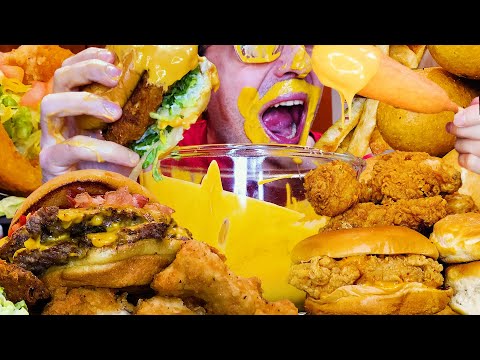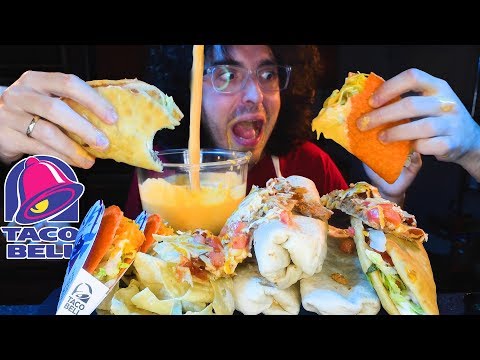ASMR Mukbanger EATING TOO MUCH CHEESE SAUCE for 3 HOURS *no talking eating sounds *
SUBSCRIBE NOW! https://bit.ly/subnomnom
The history of cheese dates back to ancient civilizations, with evidence of cheese-making dating back as far as 5,500 BC in ancient Egypt. Cheese was likely discovered by accident, as nomadic people stored milk in containers made from animal stomachs, which contain rennet, an enzyme that helps curdle milk. The curdled milk would then be drained, pressed and aged to create cheese.
The ancient Greeks and Romans had a strong cheese-making tradition, with a variety of different types of cheese being produced. In ancient Greece, cheese was a staple food for soldiers and was also used as a form of currency. In Rome, cheese was a popular food among the upper classes and was often flavored with herbs and spices.
During the Middle Ages, monasteries played a key role in the development of cheese-making techniques. Monks created new methods of aging and flavoring cheese, and many monasteries had their own cheese-making facilities. One famous example is the Roquefort cheese, which was made by monks in the Roquefort region of France and is still produced there today.
In the Renaissance, new techniques for aging and flavoring cheese were developed, and cheese became a popular food among the upper classes. Cheese-making also spread to the Americas with European colonization. The Pilgrims brought cheese-making techniques with them to the New World, and many early American settlers were farmers who produced cheese as a way to preserve milk.
In the 19th century, the industrial revolution led to the mass production of cheese, and new technologies were developed for pasteurization and standardization of cheese. This allowed for cheese to be produced on a large scale and made it more accessible to the general population.
In the 20th century, many new types of cheese were developed. The blue cheese Roquefort, brie and cheddar are some examples. With the growth of the specialty food industry, artisanal cheeses also began to gain popularity.
Today, cheese is enjoyed all over the world and there are hundreds of different types of cheese produced in various countries, with new varieties and hybrids being developed all the time. With the rise of the organic and farm-to-table movements, the focus on artisanal cheesemaking methods has experienced a resurgence in recent years.
Cheese has become a comfort food for several reasons. Cheese can be used in a wide variety of dishes, from pizza and mac and cheese to grilled cheese sandwiches and cheese boards, and can be enjoyed in both sweet and savory contexts. It can be paired with a variety of other foods and drinks, such as bread, crackers, fruit, wine, and beer.
Cheese is a source of umami, a savory taste that is often described as "meaty" or "savory". This taste is associated with comfort and satisfaction, and can make people feel good. Additionally, cheese contains a compound called casein which releases a small amount of opiates called casomorphins when digested, which can make people feel good and relaxed.
Cheese has been a part of Western culture for centuries, and it is a food that many people grew up eating. This familiarity can evoke feelings of nostalgia and comfort. Lastly, cheese is also a social food. It's often shared with friends and family, and enjoyed during special occasions and celebrations. This social aspect of cheese can also contribute to its comfort-food status.
In summary, cheese has become a comfort food in Western culture because of its versatility, taste, familiarity, and social aspect. Its ability to evoke feelings of nostalgia and comfort, as well as its ability to be enjoyed in a variety of dishes and contexts, make it a beloved food for many people.The future of cheese is likely to be shaped by a variety of factors, including consumer demand, technological advancements, and changes in agricultural practices.
As consumers become more interested in locally-sourced and sustainably-produced foods, artisanal cheeses made from high-quality, natural ingredients are likely to become more popular.
With the increasing global trade, more types of cheese from different regions will be available. With the rise of ethnic cuisine, people are becoming more familiar with different types of cheese from around the world, which could lead to an increase in demand for exotic and specialty cheeses.
Technology will play a major role in the future of cheese. Advances in fermentation technology and biotechnology can lead to the development of new types of cheese that have improved nutritional profiles and longer shelf lives.
The future of cheese is likely to be shaped by a variety of factors including consumer demand, technological advancements, and changes in agricultural practices. With the growth of the artisanal cheese market, diversification of cheese varieties, focus on health and wellness, advances in technology, and the shift towards more sustainable practices, the future of cheese looks exciting and delicious.
Last updated:














